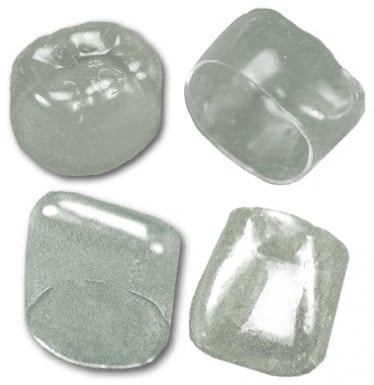Common Procedures
Stainless Steel Crowns
Stainless steel crowns, also known as 'silver crowns or caps', are a very common procedure used to restore 'baby teeth' (and occasionally permanent teeth) that have large caries or those that had a pulpotomy (baby root canal). Although most teeth can be filled with a white or silver filling material, stainless steel crowns are by far the most predictable and durable option to fix 'baby teeth' with large caries, large defects, or damaged enamel. This is particularly true in very young children that have caries at a young age, since it is preferred that the 'fixed' teeth last as long as possible.

Silver Caps for Children
Recent controversy regarding the use of Stainless Steel Crowns (SSCs) in some states have led some parents to question dental care providers more thoroughly on their use and on other alternatives. SSCs have been used in dentistry for over 50 years for primary and permanent dentition.
For primary teeth, SSCs are usually placed on teeth that have extensive caries (where two or more surfaces are extensively involved), or teeth that have pulp treatment (such as pulpotomy or pulpectomy). We also use them in teeth that will remain in the mouth for a considerably long period of time; where other materials will not last long enough.
SSCs become loose and come out of the mouth just like normal primary teeth. They work just like normal teeth do, and require the same care. Alternatives to Stainless Steel Crowns do exist, particularly for front teeth. Usually these can be one of the following:
- A prefabricated SSC that has a white facing bonded to it on the front.
- A white cap fabricated with a white filling material (Usually we call these strip crowns).
- A normal SSC that we modify by building a window in the front of it, which we later fill with a white filling material.

Strip Crowns
Strip crowns, also known as 'white crowns', is an alternative to placing crowns on primary incisors (top baby teeth) with large caries. Because these teeth are fixed using the same material that is used to place 'white fillings', this procedure is very technique sensitive and may not be an option for young children. With proper case selection, these 'fillings' may last for at least two to three years. Stainless steel crowns with 'white' facings (the front part is white) are also available, in the event that strip crowns are not an option. Your dentist will be happy to discuss all options available for aesthetic restorations on primary teeth.

Pulpotomy
Baby teeth that have large caries (cavities) and some degree of pain occasionally require that the "coronal" (top) portion of that tooth's nerve be removed before a filling or a crown (preferably) is placed. The main goal of this procedure is to preserve the baby tooth, since baby teeth help to maintain adequate room for the permanent teeth. Pulpotomies have published success rates that range from 60% to 90% and represent a good and reliable way to save a badly decayed baby tooth.

Tooth Scaling
Tartar is plaque that has had time to harden and is that white (sometimes yellow) substance found at the base of the tooth just above the gumline. Tartar is usually not removed with standard brushing and flossing and usually requires coming in to see us for proper and thorough removal.
Tooth scaling is a service that involves using a tool that is specifically designed to break-apart and remove tartar. We gently run the tooth scaling tool along the front and back surfaces of teeth that have any signs of tartar which effectively cleans the gumline and smooths the tooth enamel. Every time you come in for a dental checkup, tooth scaling is performed to help prevent future dental problems such as cavities and gum disease.